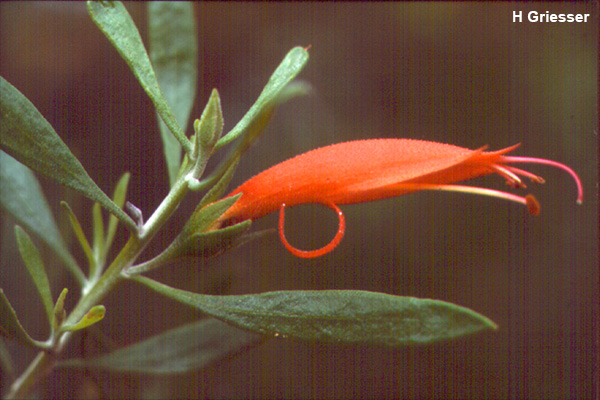General Description:
Eremophila is a large genus of 214 species, all endemic to Australia. They are generally plants of inland and arid areas and are popular with Australian plant enthusiasts.
Eremophila glabra is a very complex species with many different forms. The species ranges from completely prostrate forms to shrubs up to 1.5 metres high. Leaves may be glabrous (without hairs) or greyish and conspicuously hairy. The flowers also vary considerably and may be green, yellow, orange or red. Flowering occurs from late winter to summer.
Many forms of this species are in cultivation, eg:
- Prostrate form – a spreading shrub to 0.3 m and a spread of 1-2 metres. Yellow flowers. This is probably the hardiest form and is excellent for landscaping.
- “Murchison River” form – attractive silvery foliage with bright red flowers. This forms a shrub to about 1 metres high.
The species is best suited to dry climates but has also been successfully cultivated in warm, temperate areas. It should be grown in an open, sunny position with good drainage. The species is tolerant of at least moderate frost and, once established, tolerates extended dry periods. Forms with hairy leaves can be prone to fungal attack in humid areas.
Propagation from seed of Eremophila species is unreliable. A number of treatment methods have been tried including sowing the ripe fruits, sowing of aged and washed fruits and splitting the fruits to extract the seeds prior to sowing. The latter involves splitting the fruits in halves and quarters but some seeds are inevitably damaged during the process.
Most forms of E.glabra strike readily from cuttings.

Eremophila glabra: A typical red-flowered form
Photo: Hans Griesser

Eremophila glabra – Murchison River form
Photo: Hans Griesser

A yellow-flowered, prostrate form of Eremophila glabra
Photo: Brian Walters
Images of all Eremophila species, hybrids and cultivars can be seen in the Eremophila Study Group’s Eremophila Image Database
Other Native Plant Profiles
 Australian Native Plants Society (Australia)
Australian Native Plants Society (Australia)